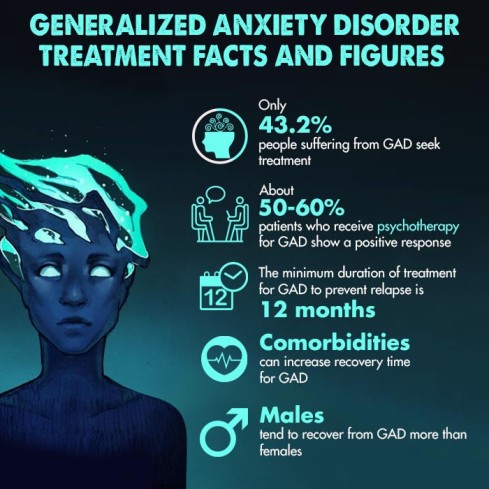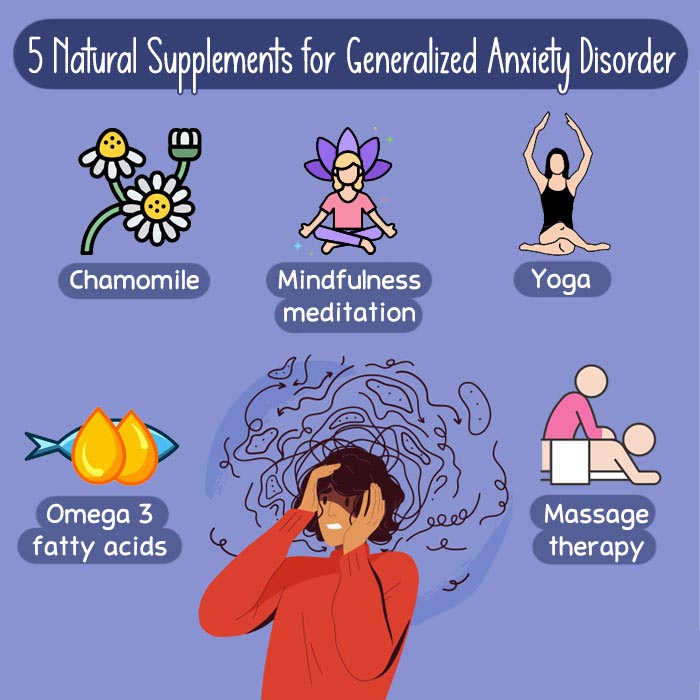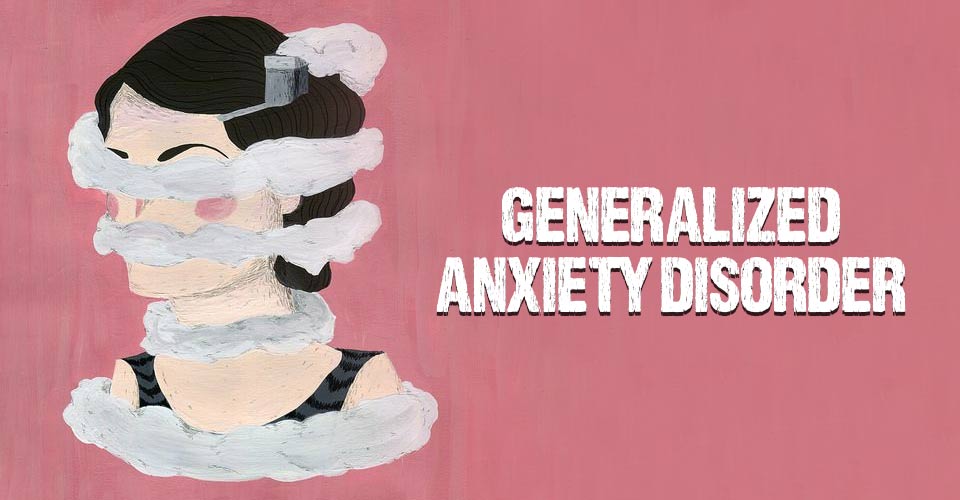Treatment for generalized anxiety disorder (GAD) can involve therapy, medication, or a combination of both. Certain alternative forms of generalized anxiety disorder treatments have also gained popularity in recent times.
Anxiety [mfn] Ströhle, A., Gensichen, J., & Domschke, K. (2018). The Diagnosis and Treatment of Anxiety Disorders. Deutsches Arzteblatt international, 155(37), 611–620. https://doi.org/10.3238/arztebl.2018.0611 [/mfn] requires treatment when it is disproportionate in relation to a threat, and keeps the affected individual from leading a normal life.
Generalized anxiety disorder can adversely affect your behavior, decision making abilities, education, career, social life, intimate relationships and other important aspects of life. Thus, it is important that you consult a professional in case you find yourself suffering from any of its symptoms.
Evidence [mfn] Bandelow, B., Boerner J, R., Kasper, S., Linden, M., Wittchen, H. U., & Möller, H. J. (2013). The diagnosis and treatment of generalized anxiety disorder. Deutsches Arzteblatt international, 110(17), 300–310. https://doi.org/10.3238/arztebl.2013.0300 [/mfn] suggests that effective long-term generalized anxiety disorder treatment involving therapy and medications can help a person eventually lead a normal life. GAD is typically treated with either psychotherapy, prescription drugs or both, depending on the severity of the condition and individual preferences.

Here are some of the most effective treatments for generalized anxiety disorder:
1. Psychotherapy
Therapy or counseling from a mental health professional can help a person overcome their anxiety to a great extent. Here are a few psychotherapy techniques that are commonly used for generalized anxiety disorder treatment.
A. Cognitive Behavioral Therapy (CBT)
Cognitive behavioral therapy is usually regarded as the first line [mfn] Borza L. (2017). Cognitive-behavioral therapy for generalized anxiety. Dialogues in clinical neuroscience, 19(2), 203–208. https://doi.org/10.31887/DCNS.2017.19.2/lborza [/mfn] of treatment for GAD when it comes to therapy. Considered the current gold standard [mfn] David, D., Cristea, I., & Hofmann, S. G. (2018). Why Cognitive Behavioral Therapy Is the Current Gold Standard of Psychotherapy. Frontiers in psychiatry, 9, 4. https://doi.org/10.3389/fpsyt.2018.00004 [/mfn] of psychotherapy, CBT is a short-term treatment which focuses on modifying faulty cognitions that give rise to anxiety, and thereby improving your coping behavior.
Read More About Cognitive Behavioral Therapy Here
B. Acceptance and Commitment Therapy (ACT)
Acceptance and commitment therapy is another effective GAD treatment [mfn] Acceptance and Commitment Therapy in the treatment of anxiety: a systematic review. (2013). In www.ncbi.nlm.nih.gov. Centre for Reviews and Dissemination (UK). Available from: https://www.ncbi.nlm.nih.gov/books/NBK159897/ [/mfn] that aims to
- Teach a person to accept unhelpful, difficult thoughts and emotions which cannot be controlled
- Help them commit and act towards building a life filled with chosen values
Researchers [mfn] Petkus, A. J., M A, & Wetherell, J. L. (2013). Acceptance and Commitment Therapy with Older Adults: Rationale and Considerations. Cognitive and behavioral practice, 20(1), 47–56. https://doi.org/10.1016/j.cbpra.2011.07.004 [/mfn] have found ACT to be especially helpful in improving symptoms in older adults [mfn] Wetherell, J. L., Afari, N., Ayers, C. R., Stoddard, J. A., Ruberg, J., Sorrell, J. T., Liu, L., Petkus, A. J., Thorp, S. R., Kraft, A., & Patterson, T. L. (2011). Acceptance and Commitment Therapy for generalized anxiety disorder in older adults: a preliminary report. Behavior therapy, 42(1), 127–134. https://doi.org/10.1016/j.beth.2010.07.002 [/mfn] with geriatric generalized anxiety disorder.
C. Psychodynamic Therapy
Also known as psychoanalytic psychotherapy or insight-oriented therapy, psychodynamic therapy aims to identify the unconscious thoughts underlying a person’s cognitions and behavior.
Research [mfn] Fonagy P. (2015). The effectiveness of psychodynamic psychotherapies: An update. World psychiatry : official journal of the World Psychiatric Association (WPA), 14(2), 137–150. https://doi.org/10.1002/wps.20235 [/mfn] reveals that short-term psychodynamic therapy can be quite effective in treating certain anxiety disorders. However, studies [mfn] Bandelow, B., Lichte, T., Rudolf, S., Wiltink, J., & Beutel, M. E. (2014). The diagnosis of and treatment recommendations for anxiety disorders. Deutsches Arzteblatt international, 111(27-28), 473–480. https://doi.org/10.3238/arztebl.2014.0473 [/mfn] have observed that in comparison with cognitive behavioral therapy, psychodynamic therapy is relatively less effective for generalized anxiety disorder treatment.
D. Interpersonal Psychotherapy (IPT)
Interpersonal psychotherapy (IPT) is a time limited therapy that has been found to be quite effective [mfn] Cuijpers, P., Donker, T., Weissman, M. M., Ravitz, P., & Cristea, I. A. (2016). Interpersonal Psychotherapy for Mental Health Problems: A Comprehensive Meta-Analysis. The American journal of psychiatry, 173(7), 680–687. https://doi.org/10.1176/appi.ajp.2015.15091141 [/mfn] in the treatment of anxiety disorders. It is based on the belief that symptoms of most mental disorders, including GAD, are closely related to the person’s social environment and interpersonal relationships.
E. Relaxation Techniques
Relaxation techniques are strategies that can help a person reduce physical symptoms that occur as a result of anxiety, such as muscle tension, shortness of breath, increased heart rate etc. According to a 2020 study [mfn] Norelli , S. K., Long, A., & Krepps, J. M. (2021). Relaxation Techniques. In StatPearls. StatPearls Publishing. Available from: https://pubmed.ncbi.nlm.nih.gov/30020610/ [/mfn], relaxation training can act as a supporting treatment option for anxiety related disorders, along with other forms of therapy.
These techniques can be learned and applied in our day-to-day life. Relaxation [mfn] Manzoni, G. M., Pagnini, F., Castelnuovo, G., & Molinari, E. (2008). Relaxation training for anxiety: a ten-years systematic review with meta-analysis. BMC psychiatry, 8, 41. https://doi.org/10.1186/1471-244X-8-41 [/mfn] techniques such as deep breathing, progressive muscle relaxation (PMR), etc. have shown significant and consistent efficacy in reducing anxiety.
2. Medications
For more severe GAD, medication might be recommended. In fact, pharmacotherapy [mfn] Farach, F. J., Pruitt, L. D., Jun, J. J., Jerud, A. B., Zoellner, L. A., & Roy-Byrne, P. P. (2012). Pharmacological treatment of anxiety disorders: current treatments and future directions. Journal of anxiety disorders, 26(8), 833–843. https://doi.org/10.1016/j.janxdis.2012.07.009 [/mfn] can go hand-in-hand with counseling.
However, it should be noted that the medications for generalized anxiety disorder treatment may cause certain side effects like sleeping problems, nausea and headaches. Thus, it is advised that you consult a doctor before starting any prescription medication, and inform them immediately in case of any side effects.
These medications may also lead to tolerance and dependence when used continuously. Hence, it is important to follow the instructions of the medical practitioner and take the medication strictly as prescribed.
Usually, the following types of medications are used in generalized anxiety disorder treatment:
A. Antidepressants
Antidepressants like selective serotonin reuptake inhibitors (SSRIs) and selective serotonin norepinephrine reuptake inhibitors (SNRIs) are considered as the most effective drugs for treating generalized anxiety disorder. Many national guidelines [mfn] Pinder R. M. (2007). Treatment of generalized anxiety disorder. Neuropsychiatric disease and treatment, 3(2), 183–184. https://doi.org/10.2147/nedt.2007.3.2.183 [/mfn] for the management of anxiety disorders recommend the use of SSRIs as first-line treatment.
However, these medications can take many weeks to show any positive effect. SSRIs, like fluoxetine [mfn] Zou, C., Ding, X., Flaherty, J. H., & Dong, B. (2013). Clinical efficacy and safety of fluoxetine in generalized anxiety disorder in Chinese patients. Neuropsychiatric disease and treatment, 9, 1661–1670. https://doi.org/10.2147/NDT.S38899 [/mfn] (Prozac) and sertraline [mfn] Brawman-Mintzer, O., Knapp, R. G., Rynn, M., Carter, R. E., & Rickels, K. (2006). Sertraline treatment for generalized anxiety disorder: a randomized, double-blind, placebo-controlled study. The Journal of clinical psychiatry, 67(6), 874–881. https://doi.org/10.4088/jcp.v67n0603 [/mfn] (Zoloft) are widely prescribed as these drugs are well tolerated by most patients. SNRIs are primarily used when SSRIs fail to be effective or patients don’t respond.
Other antidepressants, such as TCAs [mfn] Zohar, J., & Westenberg, H. G. (2000). Anxiety disorders: a review of tricyclic antidepressants and selective serotonin reuptake inhibitors. Acta psychiatrica Scandinavica. Supplementum, 403, 39–49. https://doi.org/10.1111/j.1600-0447.2000.tb10947.x [/mfn] have also been found to be effective for generalized anxiety disorder treatment.
Read More About Antidepressants Here
B. Anxiolytics
Anxiolytics like benzodiazepines are quite useful in the symptomatic management of anxiety. However, these medications also have potential side effects [mfn] Swedish Council on Health Technology Assessment. (2005). Treatment of Anxiety Disorders: A Systematic Review. Swedish Council on Health Technology Assessment (SBU). Available from: https://www.ncbi.nlm.nih.gov/books/NBK447974/ [/mfn] such as habit-formation and sedation. Thus, patients with alcohol and drug use tendencies are usually not prescribed benzodiazepines.
Buspirone (Buspar) is one medication in this category that has been found to be effective in treating GAD without leading to dependency [mfn] Munir, S., & Takov, V. (2022). Generalized Anxiety Disorder. In StatPearls. StatPearls Publishing. Available from: https://www.ncbi.nlm.nih.gov/books/NBK441870/ [/mfn].
According to a scientific review [mfn] Wilson, T. K., & Tripp, J. (2022). Buspirone. In StatPearls. StatPearls Publishing. Available from: https://www.ncbi.nlm.nih.gov/books/NBK531477/ [/mfn], buspirone is regarded as a second-line agent for treatment after selective serotonin reuptake inhibitors (SSRIs) and is usually prescribed when patients do not respond to SSRIs or are unable to cope with the side effects.
Pregabalin [mfn] Frampton J. E. (2014). Pregabalin: a review of its use in adults with generalized anxiety disorder. CNS drugs, 28(9), 835–854. https://doi.org/10.1007/s40263-014-0192-0 [/mfn], a calcium modulator, has also been proven effective in treating GAD in adults.
Alternative Treatment For Generalized Anxiety Disorder
Generalized anxiety disorder treatment without medication or psychotherapy may also be possible as per recent findings. Certain alternative treatment strategies have also proven effective in managing GAD symptoms adjunct with conventional methods, such as:
- Kundalini Yoga [mfn] Hofmann, S. G., Curtiss, J., Khalsa, S., Hoge, E., Rosenfield, D., Bui, E., Keshaviah, A., & Simon, N. (2015). Yoga for generalized anxiety disorder: design of a randomized controlled clinical trial. Contemporary clinical trials, 44, 70–76. https://doi.org/10.1016/j.cct.2015.08.003 [/mfn]
- Mindfulness-based meditation techniques [mfn] Hoge, E. A., Bui, E., Marques, L., Metcalf, C. A., Morris, L. K., Robinaugh, D. J., Worthington, J. J., Pollack, M. H., & Simon, N. M. (2013). Randomized controlled trial of mindfulness meditation for generalized anxiety disorder: effects on anxiety and stress reactivity. The Journal of clinical psychiatry, 74(8), 786–792. https://doi.org/10.4088/JCP.12m08083 [/mfn]
- Biofeedback [mfn] Ratanasiripong, P., Kaewboonchoo, O., Ratanasiripong, N., Hanklang, S., & Chumchai, P. (2015). Biofeedback Intervention for Stress, Anxiety, and Depression among Graduate Students in Public Health Nursing. Nursing research and practice, 2015, 160746. https://doi.org/10.1155/2015/160746 [/mfn]
- Massage therapy [mfn] McPherson, F., & McGraw, L. (2013). Treating generalized anxiety disorder using complementary and alternative medicine. Alternative therapies in health and medicine, 19(5), 45–50. [/mfn]
- Journaling
- L-Theanine [mfn] Hidese, S., Ogawa, S., Ota, M., Ishida, I., Yasukawa, Z., Ozeki, M., & Kunugi, H. (2019). Effects of L-Theanine Administration on Stress-Related Symptoms and Cognitive Functions in Healthy Adults: A Randomized Controlled Trial. Nutrients, 11(10), 2362. https://doi.org/10.3390/nu11102362 [/mfn]
- Chamomile [mfn] Mao, J. J., Xie, S. X., Keefe, J. R., Soeller, I., Li, Q. S., & Amsterdam, J. D. (2016). Long-term chamomile (Matricaria chamomilla L.) treatment for generalized anxiety disorder: A randomized clinical trial. Phytomedicine : international journal of phytotherapy and phytopharmacology, 23(14), 1735–1742. https://doi.org/10.1016/j.phymed.2016.10.012 [/mfn]
- Omega 3 fatty acids [mfn] Su, K. P., Tseng, P. T., Lin, P. Y., Okubo, R., Chen, T. Y., Chen, Y. W., & Matsuoka, Y. J. (2018). Association of Use of Omega-3 Polyunsaturated Fatty Acids With Changes in Severity of Anxiety Symptoms: A Systematic Review and Meta-analysis. JAMA network open, 1(5), e182327. https://doi.org/10.1001/jamanetworkopen.2018.2327 [/mfn]

Recovery From GAD Is Possible
Generalized anxiety disorder is a highly treatable mental disorder. If you think you or a loved one may be suffering from GAD, try to consult a mental health professional as soon as possible. Although generalized anxiety disorder treatment can be a time-taking and complicated process, the outcome for patients is mostly positive.
The various treatment options for generalized anxiety disorder will not only help you overcome symptoms but also help to increase your ability for day-to-day functioning and strengthen personal relationships.
Frequently Asked Questions (FAQs)
1. Is Generalized Anxiety Disorder temporary?
Generalized anxiety disorder is a chronic condition, but it can improve with treatment.
2. How long does it take for GAD to go away?
GAD usually requires long term treatment in the form of therapy and/or medication, and it can take years [mfn] Rodriguez, B. F., Weisberg, R. B., Pagano, M. E., Bruce, S. E., Spencer, M. A., Culpepper, L., & Keller, M. B. (2006). Characteristics and predictors of full and partial recovery from generalized anxiety disorder in primary care patients. The Journal of nervous and mental disease, 194(2), 91–97. https://doi.org/10.1097/01.nmd.0000198140.02154.32 [/mfn] to recover from it.
3. What is the best way to treat children with anxiety disorders?
Research [mfn] Wehry, A. M., Beesdo-Baum, K., Hennelly, M. M., Connolly, S. D., & Strawn, J. R. (2015). Assessment and treatment of anxiety disorders in children and adolescents. Current psychiatry reports, 17(7), 52. https://doi.org/10.1007/s11920-015-0591-z [/mfn] has found a combination of cognitive behavioral therapy along with SSRI medication to be most effective in treating generalized anxiety disorder in younger people.










Leave a Reply